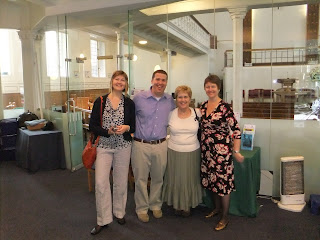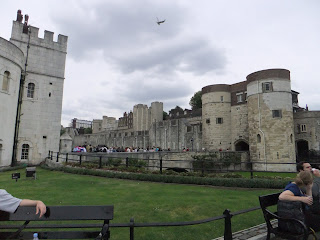I developed a case of pre-trip jitters about a week before leaving on my trip to the UK. It had been a long time since I had flown extensively and I was nervous about navigating through security and customs as well as dreading the 8 hour flight. As an avid viewer of the 7:00 o'clock evening news, I recalled Brian Williams' coverage of heightened security measures at airports, the indignity suffered by passengers required to undergo body searches, and, most troubling of all, the incidents of pilots falling asleep. Falling asleep? I had never dreamed of that possibility. I always thought that once you were up in the air, that was the safest time.
I packed and repacked my suitcase, trying to decide what to take and what to leave behind, ignoring the advice of travel guru Rick Steves to pack only the things that you will absolutely need, and then only take half of that. ("Remember," Rick says, "anything you pack, you will lug around with you everywhere you go." So true, as I later recalled while crammed onto the London Tube at rush hour, loaded down with all of my precious belongings that I could not leave behind).
As the average temperature in Winston-Salem was 95, and more like 98 in my bedroom where I was assembling and trying on mix and match ensembles and practice packing, I was having a terrible time imagining that it could possibly be 72 degrees in London and that I would even be able to tolerate a light sweater. Consequently, I packed way too few warm things, reasoning that I could always layer up if I got cold. Remembering that we were also going to Scotland where it would be even a few degrees cooler and that we would be outside at night when we attended the Military Tattoo, I threw in my dingy yellow fleece hoodie at the last minute and ended up living in it for the entire trip. It is now on my "things to burn" list.
Also fueling this case of pre-trip jitters was a nagging fear of the baggage getting lost and me arriving in London without clean underwear and a change of clothes. From past experience with overseas flights, I realized that if that happened, I would be forced to spend the first few days of my trip wandering around London in my wrinkled black jersey pants, and white ballet top dribbled with marinara sauce from the pasta dish served in the cardboard TV dinner tray that I would be lifting to my mouth on a rickety plastic fork, just as the 300 pound passenger in the seat in front of me would decide to recline into my lap, forcing the fork full of food down my shirt.
To prevent such a catastrophe from ruining my first days in London and to make sure that I would not be deprived of anything I might need on the 8 hour flight, I determined to carry on board with me a change of clothes and shoes, makeup, medication, a tiny sewing kit, first aid items, and little samples of anything I might need, in addition to Kindle, camera, cell phone, passport, US and British currency, credit cards, and all confirmations and reservations for hotels and events. If I had been traveling into the wilds of Borneo, I could not have been more prepared.
In my pre-trip obsession, I visited the US Airways website and read everything I could about getting ready for a trans Atlantic flight. Additional security measures had been put in place since my last trip abroad, as Brian Williams so helpfully pointed out, and I wanted to make sure I was updated on all of them. I carefully followed all instructions to separate out liquids and gels and have them ready for inspection at the security gate. I crammed all of my tiny samples of tooth paste, cleanser, moisturizer, eye drops, and antiseptic hand cleaner into a plastic bag where they would be visible. Then, I made certain that a 10 day supply of each of the aforementioned were packed into the bag that I would be checking, so that I would be amply supplied for the remainder of the trip, if and when I became reunited with my suitcase.
By the time August 4 finally arrived, I had completely worn myself out in preparation and anticipation. Fatigue may be just the cure for the pre-trip jitters. Having made it successfully through all of the boarding procedures, and seated on the plane ready for take off, I had only enough energy left to briefly consider the terrible possibility that the pilot might fall asleep and we might go plunging into the Atlantic Ocean in the dark of night, never to be heard from again.
Momentarily, I heard the comforting Southern drawl of the pilot, briefing us on the flight and announcing that we would be taking off in the next 10 minutes. I relaxed into my seat and thought, "This boy's not going to be falling asleep. He's going to get us there without a hitch. All I have to do now is make it through the first 10 minutes of the flight--they say the takeoff and landings are the most dangerous. Once we get in the air I can relax."
And then, my attractive young seatmate, who I later found out was on her way to London to Kings College for her first year of medical school, turned to me and said, "Don't you just love to fly? I especially like the take off. It gives me such a rush." And I said, "Oh, yes," and closed my eyes while we lifted off.
The flight was long but smooth as silk. When we began our descent to Gatwick Airport a little after 7:00 a.m. London time, a tinge of the flying jitters returned and I braced myself for the landing--the second most dangerous part of the trip. We touched down with feather like motion. It was such a gentle landing that it must have impressed the rest of the passengers as well because a spontaneous round of applause broke out in the cabin as we taxied off the runway. That Southern boy knew how to fly a plane!
With feet planted on Terra firma and loaded down with the baggage that had miraculously not gotten lost, Harry and I set out for Victoria Station, where we met up with Robert, who was a sight for sore eyes after being gone for 3 months, living in London and working at Bloomsbury Church. And, with that reunion, we began our tour of London, with Robert as our guide.
Eager to show us all of the sights, Robert took us on a walking tour of Covent Garden, the Opera House, Piccadilly Circus, and Trafalgar Square. We finished the day at a great French restaurant and then crashed for the night in our rooms at the Raddison.
View from our Hotel window in Bloomsbury.
Trafalgar Square from the National Gallery
Statue of Admiral Lord Nelson, hero of the Battle of Trafalgar
For the first time ever, a painting is being made into a ‘living wall’ outside the National Gallery. With more than 8,000 live plants, General Electric has brought a masterpiece to life with a version of Van Gogh’s famous painting A Wheatfield, with Cypresses as part of the Gallery’s carbon reduction plan.
The M and M super store at Leicester Square--3 giant stories filled with M and M related products.
Saturday, August 6
We headed out for a walking tour of the city. It was a glorious day--cool and clear and sunny. After taking a full English breakfast in the gardens of Victoria Embankment, we walked our legs off, visiting site after site along the Thames.
St. Paul's Cathedral is the backdrop for Henry's green cars, which made the trip with us.
Statue of Thomas a Becket where we overheard the British mother explaining to her small son the martyrdom of the saint: "He and King Henry (II) were best friends and the king got very cross with him--and he had him killed."
A bit of British humor on the sign for Hung, Drawn and Quarterd, a pub below the flat where Robert stayed with Margaret and Keith, in the City of London. It reads:
I went to see Major General Harrison hung, drawn, and quartered.
He was looking as cheerful as any man could in that condition.
Samuel Pepys, 13 October 1660
Tower of London
Tower of London Bridge (Not to be confused with the "London Bridge is Falling Down bridge" which is not nearly as impressive and is nearby)
The Globe Theater
The ubiquitous red double decker bus.










































